
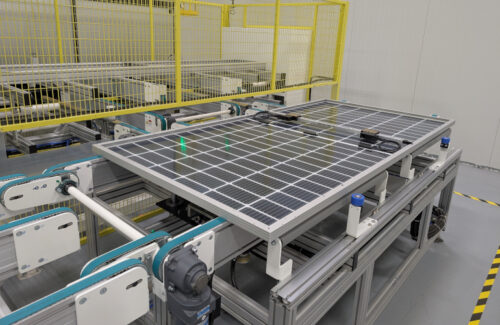
This week, Boviet Solar held a ribbon cutting ceremony for its 2 gigawatt solar panel assembly plant located in Greenville, North Carolina. The factory began fine-tuning its production line a few weeks ago, and many local and state legislators attending the ceremony, as well as Democratic state governor Josh Stein, praised it as a successful example of manufacturing in eastern North Carolina. Xie Zhaochun, Global General Manager of Bovit Solar, and Sienna Cen, President of Bovit Solar USA, also attended the ribbon cutting ceremony. The solar panel factory has hired 370 employees and will produce single-sided and double-sided solar panels for the US market. Under generous incentives from the state government, Bovit Corporation invested nearly $300 million to renovate an existing 521460 square foot (approximately 51000 square meter) building located in the Indigreen Enterprise Park. The company has also built another 500000 square foot (approximately 47000 square meters) factory nearby, which will produce 3 gigawatts (approximately 3 million kilowatts) of solar cells annually. The battery factory of Bovit Company has broken ground and is scheduled to start production in the second half of 2026. Bovit Company stated that after the completion of the two parks, it will hire 1300 employees in Greenville. I really wish I could talk more about my experience of visiting a solar panel factory this time, but surprisingly, it has become routine - I never thought that reporting on the US solar panel manufacturing market would say that before. The assembly line is running well, and the workers are also performing their respective duties. Everything is running well, like a well functioning machine, and this is precisely the current situation of rapid expansion of solar energy production capacity in the United States. I have communicated with many EPC and installation companies who participated in the ribbon cutting ceremony, and they all said the same thing: Boviet is a consistent and trustworthy company, and they have established a good cooperative relationship with Boviet. They are excited about this new factory located in the United States, but they are more looking forward to the production of the battery factory so that they can receive more incentives for localization. Bo Wei Solar Energy Company was established in Vietnam in 2013 and currently provides support to a local battery and solar panel manufacturing company. Although Bowei Solar Energy Company is not affiliated with Chinese companies, it is currently a subsidiary of Ningbo Bowei Alloy Materials Co., Ltd., a Chinese material manufacturer. About a dozen Bowei Solar employees from Greenville went to Vietnam for six weeks to learn assembly line operations. At the ribbon cutting ceremony, many supervisors and operators led a tour of the factory that was currently in production. The current solar panel factory was once the location of Denso Manufacturing Company, which produced wiper engines, electric...
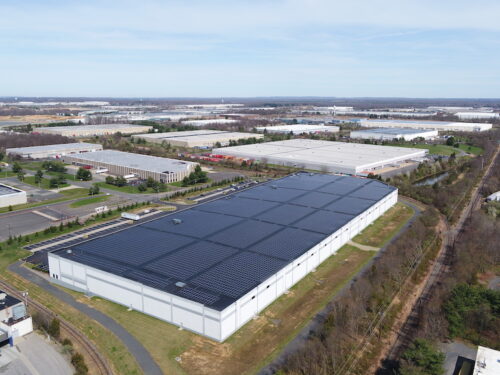
The New Jersey Public Utilities Commission (NJBPU) has approved the launch of the third round of competitive solar incentive program (CSI) bidding. The CSI program aims to reduce the cost of solar energy development and encourage the development of grid scale and other eligible solar projects in New Jersey. The committee has determined that the third round of bidding for the CSI program will commence pre qualification on May 14, 2025, and the bidding deadline will be July 23, 2025. The CSI program has significantly increased the solar installed capacity in New Jersey, with a current installed capacity exceeding 5 gigawatts and reducing costs for taxpayers. Today's action by the board of directors demonstrates the bright future of solar energy in New Jersey and reinforces the actions we have taken over the years to expand solar coverage in our great state, "said Christine Guhl Sadovy, President of the New Jersey Business Utility Association. In the past seven years, through our powerful solar energy projects, including Community Solar Energy (CSI) and Community Solar Energy, we have doubled the solar power generation of our grid. The growth of solar energy in New Jersey and the entire region has helped taxpayers save hundreds of millions of dollars in electricity bills. I am very much looking forward to how the next round of community solar projects will develop. ” The development of clean energy in New Jersey and the entire PJM region has saved New Jersey taxpayers billions of dollars in costs. If there were no onshore wind and solar resources from PJM participating in PJM's 2024 capacity auction, the liquidation price would be about 60% higher, which would result in an additional loss of approximately $1.1 billion for New Jersey taxpayers in the coming year. In the last CSI tender in 2024, the committee awarded over 310 megawatts of solar power generation capacity and 80 megawatt hours of energy storage capacity. These winning projects can provide sufficient electricity for 42000 households annually. This bidding highlights a significant policy achievement, which is the ability to develop large-scale solar projects in a competitive manner, thereby reducing costs for taxpayers in New Jersey. This is the cheapest solar project incentivized by the committee so far. Since 2017, New Jersey has helped taxpayers reduce solar energy costs by over 50%. In the third bidding, in order to promote competition, the board of directors approved the proposal to adjust the capacity target of the existing power grid supply projects, allowing construction on industrial land and floating solar projects. The capacity target for the fourth batch of net metering non residential projects exceeding 5 megawatts has been reduced from 40 megawatts to 15 megawatts to encourage more companies to actively participate in bidding for other batches. The board of directors established a consistent bidding schedule and emphasized the improvement of interconnection processes to supp...
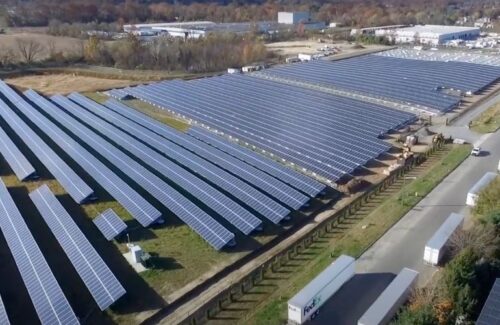
The New Jersey Public Utilities Commission (NJBPU) has approved the expansion of the New Jersey Community Solar Program (CSEP), adding 250 MW of capacity blocks. Since the first allocation of CSEP capacity in November 2023, over 500 megawatts of community solar projects have been registered under the program throughout the state. Christine Guhl Sadovy, Chair of the New Jersey Public Utilities Commission, said, "New Jersey's leading community solar program has saved and will continue to save participants millions of dollars in costs. By launching a new round of projects, we are advancing smart policies to ensure that all participants can save 20% on costs, regardless of their income level, whether your roof is suitable for installing solar energy, or whether you rent a house, ultimately helping more New Jersey households afford solar energy. Use the New Jersey Public Utilities Commission's Community Solar Project Finder to find existing projects near you and start saving money CSEP is one of the most effective and quickest methods to reduce energy bills. Community solar users participating in CSEP can receive guaranteed savings, and their community solar credit limit in their bills can enjoy a discount of 15% or higher. CSEP currently serves over 28000 users in New Jersey, who have received over $37 million in billing credit lines since the pilot project was launched, resulting in net savings of over $7 million. The addition of a 250 MW capacity block is key to helping more New Jersey taxpayers afford their electricity bills. Community solar energy enables utility users who do not have their own roofs or houses, rent, or cannot afford the upfront cost of solar energy to participate in community solar projects located within their power service areas, and must reserve at least 51% of capacity for low - and middle-income (LMI) users. In addition to opening up more capacity blocks for new projects, the Community Solar Energy Project (CSEP) has also made procedural changes to simplify the participation process and reduce barriers to cost savings. CSEP allows LMI users to prove their eligibility on their own. In addition, local governments can now submit registrations for automatic registration projects, allowing municipal authorities to choose households that are difficult to cover to directly subscribe to community solar projects and receive savings without residents taking action. The committee has also recently implemented consolidated billing, where users will see both subscription fees and net savings on their utility bills, without the need for community solar suppliers to issue separate bills. The new 250 MW capacity block will open for new project registration on April 30, 2025. The project will be included in CSEP on a first come, first served basis, but project registrations submitted within the initial registration period of 10 working days will be considered as simultaneous submissions and will be awarded based on the highest discount prov...
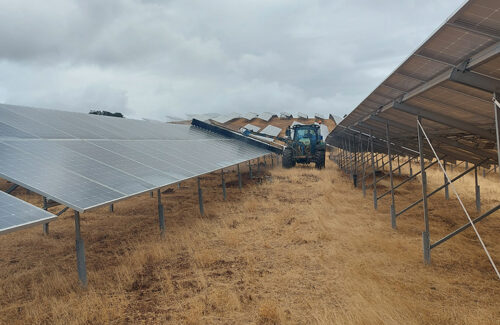
Chemitek Solar has launched Anti Static Solar Armor 2.0, a new version of its easy-to-use anti-static and anti fouling coating for photovoltaic (PV) panels. The upgraded anti-static solar armor 2.0 formula ensures durability for at least one year under normal stain conditions, ensuring that solar panels remain clean for a longer period of time and reducing the need for frequent touch ups. This formula significantly reduces the adhesion of pollutants such as dust, pollen, and organic matter, making subsequent cleaning faster and more efficient. By forming a durable protective layer, the accumulation of dirt is minimized to effectively support the long-term performance and maintenance of photovoltaic panels. The combination of anti-static and anti adhesion properties can slow down the accumulation of dirt, thereby increasing energy production by up to 5%. This product is designed specifically for use with robots (such as Solarcleano or Sun-X) and brush tractors (such as Sunbrush), and can be used in routine cleaning operations by simply mixing it directly in cleaning water. This convenient way of easily integrating into regular cleaning can avoid additional operations and costs. Adhering to the concept of sustainability, the anti-static solar armor 2.0 adopts biodegradable, non-toxic, water-based materials that do not contain solvents and irritating chemicals such as ammonia. Its pH neutral components ensure that it is harmless to the environment and solar panel components. The anti-static solar armor 2.0 has passed T Ü V safety and reliability certification, ensuring that it meets the highest industry standards. It provides optimal protection for sensitive photovoltaic modules, including anti reflective coatings (ARC). We have developed a brand new anti-static solar armor 2.0 with the goal of achieving a lifespan of at least one year to align with the annual cleaning cycle of most photovoltaic power plants worldwide. The new version will continuously protect the components between two cleanings, minimizing pollution losses throughout the year, "said C é sar Martins, CEO of Chemitek. The anti-static solar armor 2.0 will be officially released at the 2025 European International Solar Energy Exhibition.
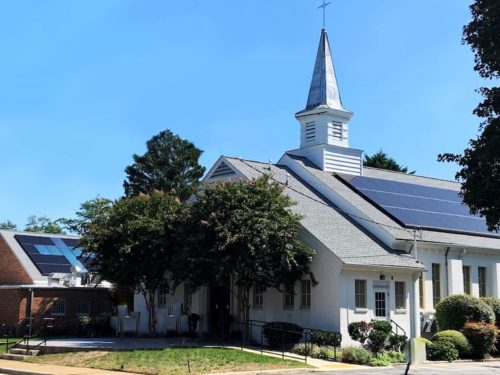
The Sixth District of the African Methodist Church (AME) has announced a new plan to establish microgrids in churches across Georgia, with the goal of installing five systems by 2026. The initiative in the sixth district covers all AME churches in Georgia (482 churches), which can ultimately deploy microgrids to enhance community resilience and energy independence, marking an important step for AME churches in their ongoing commitment to environmental management. Since 2023, the sixth district has been developing this innovative project, which includes installing solar panels, electric vehicle charging stations, battery energy storage systems, and implementing energy-saving measures. The project also introduces bidirectional charging technology, enabling church facilities to serve as energy hubs and emergency centers for the community, where community members can charge medical equipment, store medication, and seek shelter in emergency situations. It is expected that the typical solar energy system of each church will generate an average of 70 megawatt hours of electricity per year, and each system is expected to offset approximately 93.5% of the church's annual energy consumption, recovering costs in just eight years. The 482 churches in the sixth district have a total annual power generation of approximately 34 gigawatt hours, which is sufficient to power over 3000 households. The project is based on the Climate Change Resolution of the African Methodist Church (AME), which commits the denomination to climate action and supports policies for creating healthy communities and a clean energy future. The resolution was passed at the 50th General Assembly in Philadelphia, outlining the biblical basis for addressing climate change and encouraging the church to take practical measures to achieve sustainable development. Georgia is particularly vulnerable to power outages caused by extreme weather events, such as Hurricane Helene in September 2024, which caused power outages for over 1.3 million residents across the state. Some members of the African Methodist Church have experienced power outages for over three weeks. Georgia residents' electricity bills are also higher than the national average, and it is expected that electricity bills will continue to rise. So far, with the help of the faith based environmental non-profit organization Georgia Interfaith Power and Lighting Company (GIPL), the Sixth District has completed feasibility studies for 13 churches and plans to complete a total of 70 studies by the end of the year. This ambitious goal demonstrates the Church's determination to quickly and effectively address climate change. To support the implementation of this ambitious clean energy vision, AME Church's Sixth District will collaborate with Capital Good Fund. Capital Good Fund is a non-profit community development financial institution (CDFI) and a federal beneficiary of the U.S. Environmental Protection Agency's "Solar Energy for All" progr...
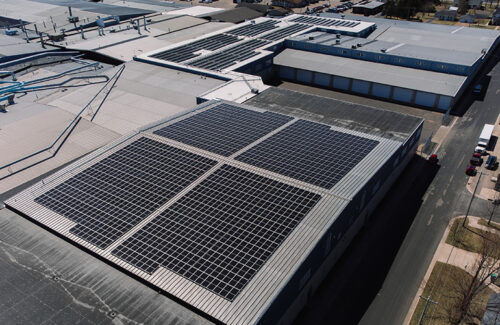
Kolbe Doors and Windows Company recently completed the installation and commissioning of a solar panel system on the roof of its main manufacturing plant located in Wausau, Wisconsin. The system consists of 2061 photovoltaic panels with a power of 999.6 kilowatts, expected to offset 31.8% of the current energy consumption of the window manufacturer's factory. Kolbe worked closely with Northwind Solar, a photovoltaic contractor from Amherst, to jointly design and install the system. This array uses double-sided components that can absorb additional sunlight reflected from the back of the panel. The installation work will begin in 2024, with some funding supported by the US Department of Agriculture's Rural Development Grant, which is part of the Rural Energy Program (REAP). We are delighted to utilize the idle space on the factory roof to do something so meaningful: improve our operational efficiency and reduce our carbon footprint, "said Jeff DeLonay, President of Kolbe Doors and Windows. This project is one of our important efforts to better serve our team, community, and environment In addition, in 2022, Kolbe installed a smaller 19.72 kW, 58 panel solar project on the roof of its innovative greenhouse located in Vostok. Kolbe's commitment to energy efficiency is not limited to solar panel systems. The company has implemented multiple measures, including installing timed controlled LED ceiling lights, optimizing humidification systems, and air replenishment devices to improve energy efficiency.
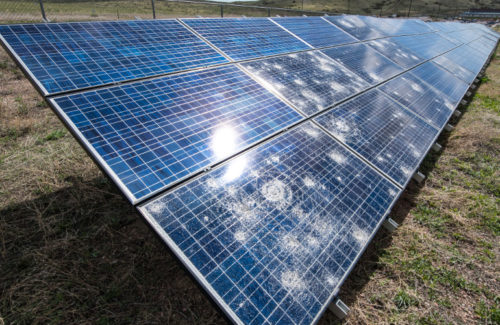
VDE Americas and kWh Analytics have released a new table to assess the hail risk of solar power plants and their defense capabilities during the upcoming hail season. Multiple high-profile hail disasters have posed challenges to the insurance of solar assets, prompting the industry to adopt resilience measures such as deploying thicker and less prone to breakage glass solar panels. But in order for insurance companies to correctly evaluate risk mitigation measures, they need data. In order to provide meaningful hail risk assessment data, VDE Americas and kWh Analytics have jointly developed the "Hail Accumulation and Risk Assessment" tool, which is an easy-to-use assessment tool for insurance insurers and financiers to confirm and monitor hail defense functions. Ultimately, projects that use this tool and demonstrate the effectiveness of its resilience measures will receive insurance credit. This tool and recommendation are based on VDE's comprehensive hail defense best practices, which include actively accumulating solar panels, utilizing industry-specific hail forecasts, and warning based hail accumulation. Hail storage refers to placing solar trackers at steep angles during hail weather to minimize impact and protect solar panels from damage. VDE Americas recommends placing solar trackers (devices used to adjust the tilt of solar panels) in hail storage locations immediately after installing solar panels in ongoing solar projects. For projects that have already been put into operation, the company recommends deploying a hail monitoring system and setting up redundant area and specific site alarms to trigger automatic or manual hail storage. After triggering, the hail storage capacity should be confirmed by staff and tested before needed. The tracker should be placed in the hail storage location overnight. The risk modeling approach of kWh Analytics and VDE America utilizes radar based meteorological data and hail resilience characteristics of specific equipment to create a data-driven model that rewards resilience design and excellent operations. By integrating reliable, site-specific hail risk data and equipment performance indicators, this method creates a more accurate risk assessment framework that benefits proactive solar energy owners and operators. Nicole Thompson, Senior Manager of Data Science at kWh Analytics, said, "This year, the La Ni ñ a phenomenon is raging, and the risk of hail is extremely high. The risk of damage to solar projects is also enormous. Based on empirical research, our differentiated premiums will reward projects that adopt mature hail prevention strategies, transmit insurance price signals to the industry, and incentivize the design, construction, and operation of more resilient solar projects KWh Analytics makes hail accumulation and risk assessment tables easy to use. It allows insurance companies to directly contact tracker manufacturers and independent engineers to understand the specific situation of the pro...
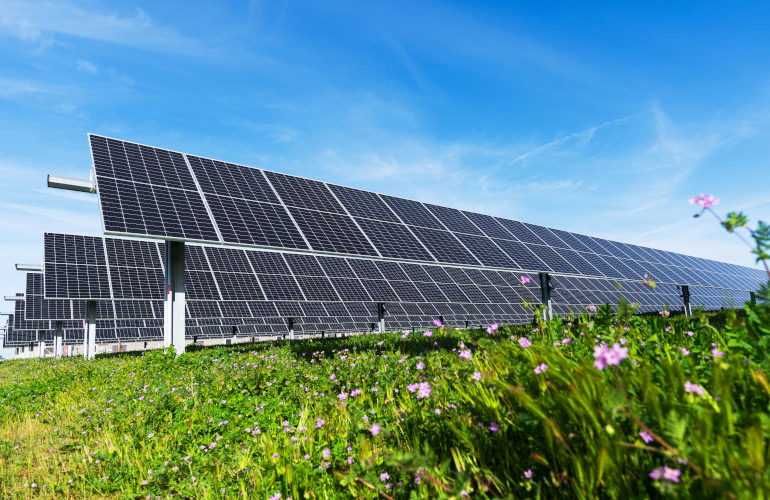
The Department of Public Utilities (DPU) in Fresno, California held a "Flip the Switch" ceremony today to celebrate the completion of solar and battery energy storage projects at three locations: the Fresno Clovis Regional Wastewater Treatment Plant, the Northeast Surface Water Treatment Plant, and the Southeast Surface Water Treatment Plant. These three projects all use single axis solar trackers. The total scale of the DPU project is 27 megawatts of direct current (and 5.3 megawatts of alternating current energy storage), and it is expected to save taxpayers over $122 million in costs by 2045. The most core part of the project is the 19.6 MW solar system and 2.3 MW energy storage system located at the Fresno Clovis area wastewater recycling facility, believed to be the largest commercial solar and battery system in the United States to date. The Fresno Department of Power (DPU) has partnered with ForeFront Power to develop a portfolio of user side solar and energy storage projects. The project was built by local union workers from IBEW Local 100, creating 120 local job opportunities. I am immensely proud of this extraordinary achievement, which not only made Fresno famous, but also fulfilled our commitment to building a sustainable Fresno, "said Mayor Jerry Dyer. Providing renewable energy for these city wide projects and DPUs is part of our comprehensive plan to reduce energy costs, ensure the safety of critical infrastructure, and enhance environmental sustainability. By injecting vitality into this vast renewable energy portfolio and supporting our public utilities, Fresno is proving to the rest of the country that clean energy is a valuable tool for serving communities We are honored to collaborate with the city of Fresno to realize their visionary energy plan, "said Dr. Ruben Fontes, CEO of ForeFront Power. The scale and influence of DPU's power plants are unique. By producing and storing clean energy on-site, DPU reduces reliance on expensive grid electricity and returns the saved energy to taxpayers. In addition, the battery energy storage system installed in each power plant ensures that there is always sufficient energy to power the important infrastructure of the city The development of DPU's solar and energy storage combination does not require prior investment from the municipal government, nor does it utilize bond funds. According to the 20-year Power Purchase Agreement (PPA) signed with the municipal government, ForeFront Power owns and maintains its solar and energy storage portfolio developed for DPU. In the next 20 years, ForeFront Power will charge DPU a fixed electricity price lower than the market, and DPU will avoid rising utility rates, thereby achieving budget certainty. During the PPA period, ForeFront Power will continue to operate and maintain the DPU solar and energy storage portfolio at no cost to DPU. As the DPU project portfolio is nearing completion, Fresno is moving towards a national milestone: having the larges...
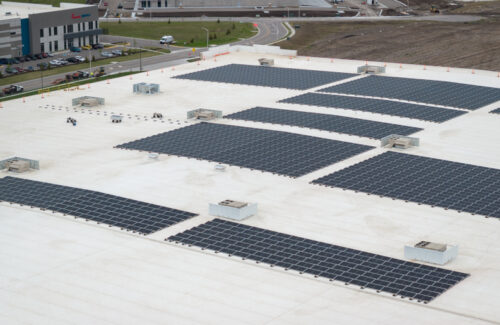
Faith Technologies Inc. (FTI) is nearing completion of its 2.16 MW solar system located on top of the newly constructed Excellerate building in Olasi, Kansas. FTI's manufacturing brand Excellerate has recently launched its first product - the Excellerate eSkid charging system for electric vehicles. FTI Assistant Project Manager Cole Morrison said, "This project reflects our commitment to putting into practice the renewable energy solutions we develop and build for our clients. With our expertise in solar technology, we have not only reduced our own carbon footprint, but also demonstrated the practical application of these sustainable energy concepts on an industrial scale This project complies with UL 3741 standards and provides a simplified method to meet the requirements for quick closure. FTI is expected to officially debug the array next month.
Categories
New Products
Tin Roof Rapid Solar Mounting System with Hanger Bolt Read More
Residential Small Solar Easy Bracket Kit for Home Balcony Read More
Automatic Single Pile Solar Tracker with 10 PV Panels Read More
Angle Adjustable Aluminum Easy Solar Panel Bracket for Garden Read More
Intelligent Single Post Dual Row Solar Tracking System Read More
5000ES Solar Off-Grid Energy Storage Inverter Supplier Read More
Multi Drive Double-Sided Single Axis Tracker System Read More
© Copyright: 2025 Xiamen Wintop New Energy Tech Co., Ltd.. All Rights Reserved.

IPv6 network supported
Friendly Links:
Integrated Solar System